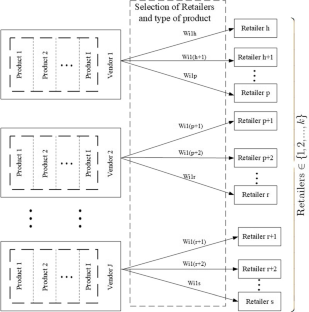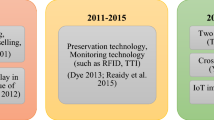Abstract
Vendor-managed inventory (VMI) policies within integrated supply chain management (SCM) represent a robust approach that effectively addresses demand, quality, and inventory management, encompassing the sharing of information and data between vendors and retailers. However, in the context of perishable products, timely inventory management becomes crucial, as its success hinges significantly on product quality, which is an area that has been relatively unexplored in the VMI literature. One emerging and efficient method to tackle VMI for perishable products is the deployment of Internet of Things (IoT) devices throughout the entire supply chain. These devices enable real-time tracking and tracing of product quality, encompassing manufacturing processes. Consequently, this study aims to develop a model for selecting the most suitable IoT devices for managing perishable products in supply chains. Despite its significance, the problem of retailer selection based on critical criteria in VMI has not been thoroughly investigated to date. This paper offers optimal policies to enhance production planning and minimize waste for suppliers by harnessing the advantages of VMI and IoT. To validate the proposed model, a case study involving real data from the food supply chain is examined.









Similar content being viewed by others
Data Availability
The data that support the findings of this study are available on request from the corresponding author. The data are not publicly available due to restrictions, e.g., their containing information that could compromise the privacy of research participants.
References
Astanti RD, Daryanto Y, Dewa PK (2022) Low-carbon supply chain model under a vendor-managed inventory partnership and carbon cap-and-trade policy. J. Open Innov. Technol. Mark, Complex, p 8
Bafandegan Emroozi V, Kazemi M, Modares A, Roozkhosh P (2024) Improving quality and reducing costs in supply chain: the develo** VIKOR method and optimization. Journal of Industrial and Management Optimization 20(2):494–524
Bafandegan Emroozi V, Modares A, Roozkhosh P (2023) A new model to optimize the human reliability based on CREAM and group decision making Abstract. Qual Reliab Eng Int. https://doi.org/10.1002/qre.3457
Bafandegan Emroozi V, Roozkhosh P, Modares A, Roozkhosh F (2023) Selecting green suppliers by considering the Internet of Things and CMCDM approach.Process Integration and Optimization for Sustainability 7(5): 1167–1189
Bazan E (2014) Vendor managed inventory (VMI) with consignment stock (CS) agreement for a two-level supply chain with an imperfect production process with/without restoration interruptions. Knowl-Based Syst 157:289–301
Ben-Dayaa M, Hassinib E, Bahrouna Z (2017) Internet of Things and supply chain management: a literature review International Journal of Production Research 4719–4742
Borgia E (2014) The Internet of Things vision: key features, applications and open issues. Comput Commun 54:1–31
Bieniek M (2017) The ubiquitous nature of inventory: vendor managed consignment inventory in adverse market conditions. Eur J Oper Res 291(2):411–420
Busacca PG, Marseguerra M, Zio E (2007) Multi-objective optimization by genetic algorithms: application to safety systems. Reliab Eng Syst Saf 72:59–74
Cammarano A, Varriale V, Michelino F, Caputo M (2022) Blockchain as enabling factor for implementing RFID and IoT technologies in VMI: a simulation on the Parmigiano Reggiano supply chain. Operations Management Research 1–29
Chiou HK, Tzeng GH (2022) An extended approach of multicriteria optimization for MODM problems. In: Multi-Objective Programming and Goal Programming. Advances in Soft Computing 21:111–116. https://doi.org/10.1007/978-3-540-36510-513
Choudhary D, Shankar R (2022) The value of VMI beyond information sharing in a single supplier multiple retailers supply chain under a nonstationary (Rn, Sn) policy. Omega 5:59–70
Darwish M, Odah OM (2010) Vendor managed inventory model for single-vendor multiretailer supply chains. Eur J Oper Res 204(3):473–484
Dasaklis T, Casino F (2019) Improving vendor-managed inventory strategy based on Internet of Things (IoT) applications and blockchain technology. In 2019 IEEE International Conference on Blockchain and Cryptocurrency (ICBC). IEEE. (50–55)
Edwards C, Hopkins J (2018) The Australian supply chain tech survey results. Loganholme, Australia, SCLAA
Elliott MA (2010) Selecting numerical scales for pairwise comparisons. Reliability Engineering & System Safety 95(7):750–763
Fang X, Chen HC (2021) Using vendor management inventory system for goods inventory management in IoT manufacturing. Enterprise Information Systems 1–27
Garg H, Sharma S (1995) Computers industrial engineering. In Proceedings of ICNN’95 -International Conference on Neural Networks 58–191
Gibson M, Bernardo J, Chung C, Badinelli R (1987) A comparison of interactive multiple-objective decision making procedures. Comput Oper Res 14(2):97–105. https://doi.org/10.1016/0305-0548(87)90002-5
Giovanni P (2021) Smart supply chains with vendor managed inventory, coordination, and environmental performance. Eur J Oper Res 299(2):515–531
Goyal S (1995) A one-vendor multi-buyer integrated inventory model: a comment. Eur J Oper Res 82:209–210
Heising JK, Dekker M, Bartels PV, Van Boekel MAJS (2014) Monitoring the quality of perishable foods: opportunities for intelligent packaging. Crit Rev Food Sci Nutr 54(5):645–654
Hu B, Meng C, Xu D, Son Y (2018) Supply chain coordination under vendor managed inventory-consignment stocking contracts with wholesale price constraint and fairness. Int J Prod Econ 202:21–31
Holland JH (2002) Adaptation in natural and artificial systems, Michigan: an overview of the current state-of-the-art. European Journal Operation Research 137:1–9
Jarek S (2016) Removing inconsistency in pairwise comparisons matrix in the AHP. Multiple Criteria Decision Making 11:63–76
Karbasi-bonab V, Yousefi Nejad Attari M, Neishabouri E (2018) Presenting a bi-objective vendor managed inventory model with fuzzy demand for multiple vendor. Journal of Decisions and Operations Research 2(2):147–168
Karimi M, Niknamfar A (2017) A vendor-managed inventory system considering the redundancy allocation problem and carbon emissions. International Journal of Management Science and Engineering Management 12(4):269–279
Kao CY, Chueh HE (2022) A vendor-managed inventory mechanism based on SCADA of Internet of Things framework. Electronics 11(6):881
Kim S, Kim S (2016) A multicriteria approach toward discovering killer IOT application in Korea. Technol Forecast Soc Chang 102:143–155
Kennedy J, Eberhart R (2013) Multi-objective reliability-redundancy allocation problem using particle swarm optimization. Computers Industrial Engineering 247–255
Kumar A, Sah B, Singh AR, Deng Y, He X, Kumar P, Bansal RC (2017) A review of multi criteria decision making (MCDM) towards sustainable renewable energy development. Renew Sustain Energy Rev 69:596–609
Kusuma P, Kallista M (2022) Collaborative vender managed inventory model by using multi agent system and continuous review (r,Q) replenishment policy. Journal of Applied Engineering Science
Lalwani P, Banka H, Kumar C (2017) GSA-CHSR: gravitational search algorithm for cluster head selection and routing in wireless sensor networks. Applications of Soft Computing for the Web. https://doi.org/10.1007/978-981-10-7098-3-13
Li X, Wang W, Zhao X, Zai J, Zhao Q, Li Y, Cha A (2020) Ransmission dynamics and evolutionary history of 2019-nCoV. Med Virol 91:501–511
Liu W, Ke JV, Chen J, Zhang L (2020) Scheduling the distribution of blood products: a vendor-managed inventory routing approach. Transportation Research Part E: Logistics and Transportation Review 140:274–292
Liu X, Sun Y (2017) Information flow control of vendor-managed inventory based on Internet of Things. In International Conference on Computer Science and Information Engineering (448–454). Springer, Berlin, Heidelberg
Lotfi R, Kargar B, Rajabzadeh M, Hesabi F, Ozceylan E (2022) Hybrid fuzzy and data-driven robust optimization for resilience and sustainable health care supply chain with vendor-managed inventory approach. Int. J, Fuzzy Syst
Maheshwari P, Kamble S, Pundir A, Belhadi A, Ndubisi NO, Tiwari S (2021) Internet of Things for perishable inventory management systems: an application and managerial insights for micro, small and medium enterprises. Annals of Operations Research 1–29
Manavalan E, Jayakrishna K (2018) A review of Internet of Things (IoT) embedded sustainable supply chain for Industry 4.0 requirements. Computers & Industrial Engineering 127:925–953
Massam BH (1988) Multi-criteria decision making (MCDM) techniques in planning. Prog Plan 30:1–84
Mital M, Choudhary P, Chang V, Papa A, Pani AK (2017) Adoption of Internet of Things in India: a test of competing models using a structured equation modeling approach. Technological Forecasting & Social Change
Modares A, Kazemi M, Bafandegan Emroozi V, Roozkhosh P (2023) A new supply chain design to solve supplier selection based on Internet of Things and delivery reliability. Journal of Industrial and Management Optimization 19(11):7993–8028. https://doi.org/10.3934/jimo.2023028
Modares A, Motahari Farimani N, Bafandegan Emroozi V (2023) A vendor-managed inventory model based on optimal retailers selection and reliability of supply chain. Journal of Industrial and Management Optimization 19(5):3075–3106. https://doi.org/10.3934/jimo.2022078
Modares A, Motahari Farimani N, Bafandegan Emroozi V (2023) Applying a multi-criteria group decision-making method in a probabilistic environment for supplier selection (Case study: Urban railway in Iran). Journal of Optimization in Industrial Engineering 16(1):129–140. https://doi.org/10.22094/joie.2023.1950386.1929
Modares A, Motahari Farimani N, Dehghanian F (2024) A new vendor-managed inventory four-tier model based on reducing environmental impacts and optimal suppliers selection under uncertainty. Journal of Industrial and Management Optimization 20(1):188–220. https://doi.org/10.3934/jimo.2023074
Mohammadi M, Rezaei J (2020) Bayesian best-worst method: a probabilistic group decision-making model. Omega 96. https://doi.org/10.1016/j.omega.2019.06.001
Poursoltan L, Seyedhosseini SM, Jabbarzadeh A (2021) A two-level closed-loop supply chain under the constract of vendor managed inventory with learning: a novel hybrid algorithm. J Ind Prod Eng 38(4):254–270
Rezaei J (2015) Best-worst multi-criteria decision-making method. Omega 53:49–57
Saaty TL (1977) A scaling method for priorities in hierarchical structures. J Math Psychol 15(3):234–281
Sadeghi J, Mousavi S, Niaki S, Sadeghi S (2013) Optimizing a multi-vendor multi-retailer vendor managed inventory problem: two tuned metaheuristic algorithms. Knowl-Based Syst 50:159–170
Sadeghi J, Mousavi S, Niaki S, Sadeghi S (2014) Optimizing a bi-objective inventory model of a three-echelon supply chain using a tuned hybrid bat algorithm. Transp Res Part E 70:274–292
Sainathan A, Groenevelt H (2019) Vendor managed inventory contracts-coordinating the supply chain while looking from the vendor’s perspective. Eur J Oper Res 272:249–260
Shafique MN, Rashid A, Bajwa I, Kazmi R (2018) Effect of IoT capabilities and energy consumption behavior on green supply chain integration. Appl Sci 8:2481
Shankar U (2017) How the Internet of Things impacts supply chains. In bound Logistics, white paper
Shang X, Zhang G, Jia B, Almanaseer M (2022) The healthcare supply location-inventory routing problem: a robust approach. Transportation Research Part E: Logistics and Transportation Review 158
Tirkolaee EB, Alinaghian M, Sasi MB, Esfahani MMS (2019) Solving a robust capacitated arc routing problem using a hybrid simulated annealing algorithm: a waste collection application. Journal of Industrial Engineering and Management Studies 3:61–76
Kilic E, Ali S, Weber GW, Dubey R (2014) A value-adding approach to reliability under preventive maintenance costs and its applications, Optimization. Journal of Mathematical Programming and Operations Research 63:1805–1816
You P, Chen T (2005) An efficient heuristic for series-parallel redundant reliability problems. Comput Oper Res 32:17–27
Ardakan M, Hamadani A, Naghian A (2014) Optimizing bi-objective redundancy allocation problem with a mixed redundancy strategy. ISA Trans 55:116–128
Stellingwerf HM, Kanellopoulos A, Cruijssen F, Bloemhof J (2019) Fair gain allocation in eco-efficient vendor-managed inventory cooperation. J Clean Prod 231:746–755
Verdouw CN, Wolfert J, Beulens A, Rialland A (2015) Virtualization of food supply chains with the Internet of Things. J Food Eng 176:128–136
Wang Y, Geng X, Zhang F, Ruan J (2018) An immune genetic algorithm for multi-echelon inventory cost control of IoT based supply chains. IEEE Access 6:8547–8555
Wettasinghe J, Trung Luong H (2020) A vendor managed inventory policy with emergency orders. J Ind Prod Eng 37(2–3):120–133
Weibhuhn S, Hoberg K (2021) Designing smart replenishment systems: Internet-of-Things technology for vendor-managed inventory at end consumers. Eur J Oper Res 295(3):949–964
Xu L, He W, Li S (2014) Internet of Things in industries: a survey. IEEE Trans Industr Inf 10(4):2233–2243
Yan R (2017) Optimization approach for increasing revenue of perishable product supply chain with the Internet of Things. Industrial Management & Data Systems 117(4):729–741
Yao Y, Dresner M (2008) The inventory value of information sharing continuous replenishment and vendor-managed inventory. Transportation Research Part E: Logistics and Transportation Review 44(3):361–378
Yousefnezhad N, Malhi A, Främling K (2020) TSecurity in product lifecycle of IoT devices: a survey. J Netw Comput Appl 171. https://doi.org/10.1016/j.jnca.2020.102779
Zavadskas EK, Turskis Z, Kildienė S (2014) State of art surveys of overviews on MCDM/MADM methods. Technol Econ Dev Econ 20(1):165–179
Zhu L (2020) Optimization and simulation for e-commerce supply chain in the Internet of Things environment. Complexity
Author information
Authors and Affiliations
Corresponding author
Ethics declarations
Ethical Approval
Hereby, we consciously assure that for this manuscript, the following is fulfilled: (1) This material is the authors’ own original work, which has not been previously published elsewhere. (2) The paper is not currently being considered for publication elsewhere. (3) The paper reflects the authors’ own research and analysis in a truthful and complete manner. (4) The paper properly credits the meaningful contributions of co-authors and co-researchers. (5) The results are appropriately placed in the context of prior and existing research. (6) All sources used are properly disclosed (correct citation). Literally copying of text must be indicated as such by using quotation marks and giving proper references. (7) All authors have been personally and actively involved in substantial work leading to the paper and will take public responsibility for its content.
Conflict of Interest
The authors declare no competing interests.
Additional information
Publisher's Note
Springer Nature remains neutral with regard to jurisdictional claims in published maps and institutional affiliations.
Appendix
Appendix
Data of case study
Rights and permissions
Springer Nature or its licensor (e.g. a society or other partner) holds exclusive rights to this article under a publishing agreement with the author(s) or other rightsholder(s); author self-archiving of the accepted manuscript version of this article is solely governed by the terms of such publishing agreement and applicable law.
About this article
Cite this article
Bafandegan Emroozi, V., Modares, A., Roozkhosh, P. et al. A Novel Integrated Supply Chain Model to Manage Perishable Products Demand and Quality by Applying IoT in Vendor-Managed Inventory. Process Integr Optim Sustain (2024). https://doi.org/10.1007/s41660-024-00421-7
Received:
Revised:
Accepted:
Published:
DOI: https://doi.org/10.1007/s41660-024-00421-7




